Alongside
Edvard Grieg, Johann Svendsen was the most important Norwegian
composer of his generation, as well as a talented conductor and
violinist. Like Grieg he studied at Leipzig, but as his career
developed he travelled further afield. At the end of the 1860s
he was in Paris, before moving on Weimar, where he worked with
Franz Liszt. He was also on friendly terms with Wagner, who invited
him to join the orchestra at the inaugural concert for his new
operatic project at Bayreuth. During the mid-1870s Svendsen returned
home to Norway, conducting and teaching in Christiania (Oslo).
The major and final part of his career was spent at Copenhagen,
where from 1883 he was conductor of the Court Opera.
These
two symphonies confirm that as a composer Svendsen was most accomplished,
and he can fairly be described as 'the first Norwegian symphonist'.
Grieg certainly admired his gifts, declaring 'Svendsen has precisely
all that which I don't have: mastery of the orchestra and its
large classical forms'. These achievements resulted from an eclectic
taste, including a close study of Berlioz's Treatise on Orchestration,
combined with an awareness of masters of nineteenth century music,
such as Beethoven, Mendelssohn and Schumann.
Of
these two pieces the Symphony No. 2 is a good deal more successful
than its predecessor, despite the enthusiasm of the insert notes.
There are some interesting moments, but the symphony evolves without
ever developing a compelling sweep. Jansons and the fine Oslo
Orchestra are the right performers in this repertoire, to be sure,
but even they cannot hide the lack of true symphonic tension in
this early work.
The
Symphony No. 2 is a different matter, and its opening phase generates
a terrific sweep of powerfully imaginative, genuinely symphonic
material. The scoring too is masterly, and the rich-toned strings
of the Oslo Philharmonic do Svendsen proud. If the slow movement
is more fitfully involving, there are some fine opportunities,
including once again the excellence of the strings in the eloquent
central section.
In
the third movement Intermezzo it is the woodwind players who are
heard to best advantage. The outer sections sound for all the
world like Grieg, before the sweeping lines of the strings reveal
Svendsen's own identity. Both symphonies are unusual in having
slow introductions to their finales. In No. 2 the sustained string
lines release an attractive Allegro con fuoco which drives through
to a compelling conclusion, aided here by the committed conducting
of Marriss Jansons and the fine playing of his orchestra.
While
the music on offer lacks the searing intensity of genius, it is
well organised and, in the Second Symphony particularly, most
rewarding to the listener. The recorded sound is warm and truthful
and the packaging efficient, although quite why EMI decided to
give nearly half the booklet space to self-advertising is open
to question. More about the music (the notes are thin) would be
a better advertisement for the product than a series of glossy
pictures of other issues in the series.
Terry
Barfoot
